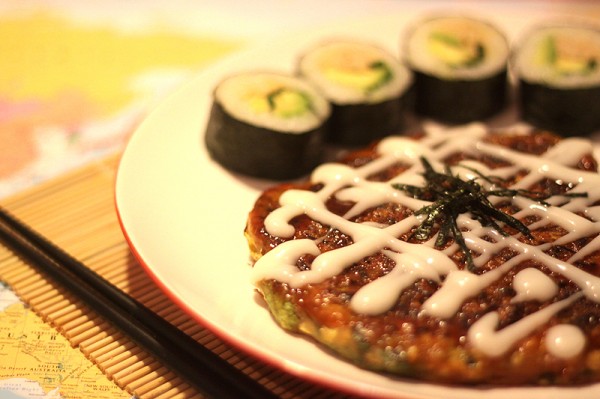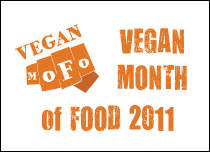Vegan MoFo day 12: Turning Japanese
By Erinwiko on Oct 12, 2011 | In Food porn | 3 Comments

I used to have a love-hate relationship with Japanese food. Love because, well, for the most part it’s delicious. Hate because I’ve never known suffering like I did when I sat through the annual peace ceremony in the scorching summer Hiroshima sun with the worst hangover I’ve ever experienced- and then, try as I might, couldn’t find any suitably greasy food to help deal with it.
It was on this trip to Japan to represent my university at an international student’s conference that I was introduced to Japanese food beyond teriyaki and sushi. On my first day in Hiroshima, the conference coordinators (before taking us to the open bar that caused aforementioned hangover) treated us to a local street food specialty at a hole-in-the-wall ‘restaurant’. That specialty was okonomiyaki.
Okonomiyaki is difficult to describe. Is it a pancake? Is it some kind of pizza? Who cares? What is really is, is a mish-mash of vegetables formed into some kind of pizza/pancake shape, fried and topped with zesty okonomiyaki sauce. I used this recipe from Veg News to recreate this dish. A few substitutions had to be made- namely, potato for nagaimo- and the recipe suffered for that. There’s also a typo in the online version of the recipe. I took a stab at the quantity of flour needed, but may have gotten it wrong since this was a bit gummy in the middle. But the edges were tasty- not as crisp as the okonomiyaki I sampled in Hiroshima, but not bad for a first try.
Since Chadwiko is a late bloomer when it comes to Japanese food and has only just recently jumped on the sushi bandwagon, I served this with the spicy tempeh nori rolls from Veganomicon. Filled with spicy tempeh broken down to resemble tuna, with avocado and spring onion, these are always a winner. And bonus- easy enough to make that Chadwiko has even promised to attempt his own one night.
All he needs is an apron and a headband tied around his forehead and I’ll feel like I’m right back in Hiroshima- but I think I’ll leave the hangover behind this time.













